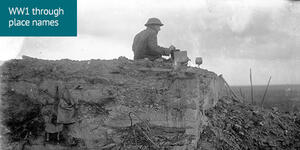
Unidentified New Zealand World War 1 signaller on a German dug-out, Gallipoli Farm, Belgium, 12 October 1917
Paschendale Ridge, Westland National Park / Tai Poutini National Park
The name of this feature is a misspelling of one of the First World War’s most well known battlefields.
Fought between July and November 1917, the Passchendaele Campaign around the Belgian city of Ypres has come to symbolise the dreadful conditions encountered by soldiers. In heavy rains that reduced the ground to mud, both sides carried out a series of offensives where gains were usually measured in yards rather than miles. British Field Marshal Sir Douglas Haig has been criticised by many historians for continuing the battle even after all hope of a breakthrough had passed. Total Allied casualties numbered between 200,000 and 400,000; with the German forces sustaining similar loses.
Passchendaele proved particularly costly for the New Zealand Division, which suffered more than 18,000 casualties. Although it did carry out some successful actions, such as the capture of Gravenstafel Spur, the Division also endured the bloodiest day in New Zealand’s military history. On 12 October 1917, at Bellevue Spur, 845 of its men were killed and over 2,700 wounded in an attack lasting only a few hours.
Paschendale Ridge first appeared on New Zealand maps around 1970. The reason for the misspelling is unclear, although it is relatively common to see the name produced in different forms. Indeed, ‘Passchendaele’ is itself obsolete, as the village in Belgium is now titled ‘Passendale’.
References:
- New Zealand Geographic Board, ‘New Zealand Gazetteer’
- NZ History, ‘Passchendaele: Fighting for Belgium’
- World War One Battlefields, ‘Passchendaele’
Passchendaele Ice Fall, South Main Divide
Situated between Passchendaele Peak and Mount Destiny, this glacier is named after one of the First World War’s bloodiest confrontations.
Fought between July and November 1917, the Passchendaele Campaign around the Belgian city of Ypres has come to symbolise the dreadful conditions that soldiers faced. In heavy rains that reduced the ground to mud, both sides carried out a series of offensives where gains were usually measured in yards rather than miles. British Field Marshal Sir Douglas Haig has been criticised by many historians for continuing the battle even after all hope of a breakthrough had passed. Total Allied casualties numbered between 200,000 and 400,000; with the German forces sustaining similar loses.
Passchendaele proved particularly costly for the New Zealand Division, which suffered more than 18,000 casualties. Although it did carry out some successful actions, such as the capture of Gravenstafel Spur, the Division also endured the bloodiest day in New Zealand’s military history. On 12 October 1917, at Bellevue Spur, 845 of its men were killed and over 2,700 wounded in an attack lasting only a few hours.
The name Passchendaele Ice Fall was first assigned by the Honorary Geographic Board of New Zealand in 1938, and was officially confirmed by the New Zealand Geographic Board in 1948.
References:
- Honorary Geographic Board of New Zealand: Minutes, 1938 (90)
- New Zealand Geographic Board: Correspondence, vol. 35, pp. 53-57
- New Zealand Geographic Board: Minutes, 1948 (42)
- New Zealand Geographic Board, ‘New Zealand Gazetteer’
- NZ History, ‘Passchendaele: Fighting for Belgium’
Passchendaele Peak, South Main Divide
This feature is named after one of the bloodiest confrontations of the First World War.
Fought between July and November 1917, the Passchendaele Campaign around the Belgian city of Ypres has come to symbolise the dreadful conditions that soldiers faced. In heavy rains that reduced the ground to mud, both sides carried out a series of offensives where gains were usually measured in yards rather than miles. British Field Marshal Sir Douglas Haig has been criticised by many historians for continuing the battle even after all hope of a breakthrough had passed. Total Allied casualties numbered between 200,000 and 400,000; with the German forces sustaining similar loses.
Passchendaele proved particularly costly for the New Zealand Division, which suffered more than 18,000 casualties. Although it did carry out some successful actions, such as the capture of Gravenstafel Spur, the Division also endured the bloodiest day in New Zealand’s military history. On 12 October 1917, at Bellevue Spur, 845 of its men were killed and over 2,700 wounded in an attack lasting only a few hours.
Climbers originally referred to this feature as ‘Mount Passchendaele’. However, it was believed that confusion might arise with the feature of the same name (which later became known as Passchendaele Ridge) in the Cook District. After an investigation by the Honorary Geographic Board of New Zealand, the official name was assigned as Passchendaele Peak in 1938. The New Zealand Geographic Board then confirmed this decision in 1948.
References:
- Honorary Geographic Board of New Zealand: Correspondence, vol. 14, p. 51
- Honorary Geographic Board of New Zealand: Minutes, 1938 (75)
- New Zealand Geographic Board: Correspondence, vol. 24, p. 7
- New Zealand Geographic Board Minutes, 1948 (42)
- New Zealand Geographic Board, ‘New Zealand Gazetteer’
- NZ History, ‘Passchendaele: Fighting for Belgium’